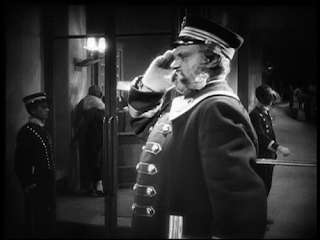At a lecture about Jean Renoir's The Rules of the Game (1939) at Stockholm University in the 1990s the lecturer was talking, among other things, about Renoir's "revolutionary" use of deep focus. The lecturer was bad, confused deep focus with deep space, and the central argument was very weak. Yet as I soon discovered this is how historians and scholars in general view deep focus, or depth of field. Here is typical quote taken from a standard textbook, David A. Cook's A History of Narrative Film (4th edition, 2004): "Renoir was the first major director of the sound film to compose his shots in depth." (p. 322)
Today almost all writing on deep focus is about Orson Welles, the cinematographer Gregg Toland and their work on Citizen Kane (1941). Here are some more quotes from textbooks that are often required readings for university students:
In the third edition of The Cinema Book (2007) it says: "Deep-focus cinematography, in which objects in several planes of depth are kept in equally sharp focus, is commonly associated with certain Hollywood films of the 1940s. Patrick Ogle dates its emergence at around 1941." (p. 149. Although the phrasing in the quote make it sound ambiguous there is no effort to question that association or Ogle.)
The above quoted Cook also writes that "the creative genius of Orson Welles and Gregg Toland, restored the cinema's physical capacity for deep focus". (p. 322)
In The Story of Film (2004, the book from which the series springs), Mark Cousins writes that in the 1940s "[t]he visual ideas of Welles and Toland started to influence John Huston and William Wyler" (p. 179).
Understanding Film Theory (2011) add this caveat to the section about deep focus in Citizen Kane: "This technique was not new and had been practised in France by Jean Renoir." (p. 47)
These quotes are just a few examples. A person who is reading a book or essay that mentions deep focus would almost certainly conclude that it was something that appeared in the 1930s in the films of Jean Renoir and then became common in the 1940s thanks to the innovations in Citizen Kane. What is puzzling is that this is transparently wrong. Despite these claims many major filmmakers such as Kenji Mizoguchi, Frank Borzage, Howard Hawks, Sadao Yamanaka, Alfred Hitchcock, Henry Hathaway, William Wyler and John Ford used deep focus all through the 1930s, and earlier. Another key player was cinematographer James Wong Howe. Contra Cousins's statement it should be said that Wyler's films in the 1940s look rather like the films he made in the 1930s, deep focus and all, but not really like Welles's films. Generally Welles is more baroque and expressionistic whereas Wyler is more calm and naturalistic. An exception perhaps is Wyler's Dead End (1937), which Toland shot, and which is rather expressionistic, both in its use of depth and lighting, more so than usual for Wyler. But that was of course several years before Citizen Kane. If anybody influenced anybody it was Wyler who influenced Welles.
Dead End
This is just after the wife has discovered that he has died.
F.W. Murnau was another master of deep focus compositions. Here is an example from The Last Laugh (1924).
So there is nothing new or special about Renoir's and Welles's use of deep focus. Actually, in itself deep focus is not particularly special at all. It is how you use it that matters, not that you use it. Here is an image from Make Way For Tomorrow (Leo McCarey, 1937), with a lot of depth, but the depth has a different meaning than in the examples above. Here it is to emphasis her solitude, like if she was modelling for an Edward Hopper painting.
Where these mistaken ideas come from is not clear, possibly with André Bazin's writings on deep focus in the late 1940s and early 1950s, for example the essay "The evolution of the language of cinema". It seems film scholars are more keen on reading books than watching films, and since most books write the same things the mistakes and errors continues. But by looking at films from the 1920s and 1930s it is easy to see how prevalent deep focus was, and in how many different ways it was being used. A film like Ford's Stagecoach (1939), that used expressive deep focus before Citizen Kane, is usually described as a rare precursor. Instead it should be seen as a good example of a rather common form of filmmaking. Often when film history gets distorted it is in order to simplify but that is not the case with the history of deep focus. It is not less simple to rightfully say "Deep focus has been a tool used by many filmmakers since the dawn of cinema." instead of wrongfully claim "Deep focus tentatively appeared in the 1930s and then became common after 1941."
Here, finally, is another marvellous Wyler shot. This is from Dodsworth (1936):
--------------------------------
Another thing to keep in mind is that what appears to be deep focus is sometimes an illusion, through matte paintings, set design or trick filming (such as splicing two different shots together through an optical printer), and not technically deep focus at all. This is the case with some of the most famous shots from Citizen Kane. Special effects has been used ever since the dawn of cinema, and that includes faking deep focus.
The eagerness to equate deep focus with Gregg Toland becomes comical in The Film Experience - An Introduction (2009). There his work on Wyler's The Heiress (1949) is mentioned (p. 102) which is peculiar because it was made after Toland's death. Leo Tover was its cinematographer.
Three earlier posts on problems with conventional film history:
http://fredrikonfilm.blogspot.se/2012/09/on-film-history-and-art-of-studying-it.html
http://fredrikonfilm.blogspot.se/2011/03/max-weber-goes-to-movies.html
http://fredrikonfilm.blogspot.se/2012/03/on-history-of-auteurs.html





